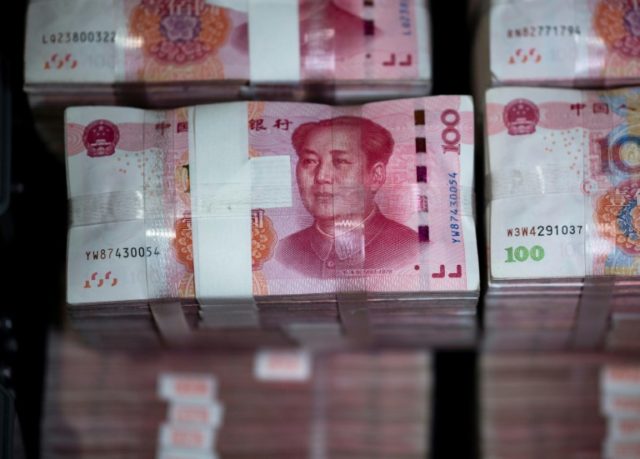China’s massive Belt and Road infrastructure initiative (BRI) appears to be running low on both government and private funds, according to a study published on Wednesday by the American Enterprise Institute.
The key finding of the AEI study is that investment in Belt and Road projects by private sector firms is lagging far behind the pace of construction. The share of private investment fell by 12 percent in the first half of 2018, even as a growing list of Belt and Road projects reached into 117 countries. Overall, the Chinese initiative now boasts $256 billion worth of construction but only $148 billion in investment.
Compounding the instability of Belt and Road – also known as One Belt, One Road (OBOR) – financing is the stress placed on China’s economy by its trade war with the United States. The conflict has gone more poorly for Beijing than anticipated, leaving it with less money to spend on Belt and Road at a crucial moment when developing countries are rethinking their commitment to the project and private investors are backing away.
Another interesting quirk AEI’s research uncovered is that China’s hybrid public-private mega-corporations are not quite the obedient instruments of aggressive central policy Beijing might have hoped for. Many Belt and Road projects are meant to expand China’s political influence across the hemisphere, but they are not terribly profitable.
The prospect of making Third World countries dependent on Chinese engineers to maintain their expensive new trains and power stations is tremendously appealing to the Communist Party but not for the Chinese engineers actually charged with doing the work, or the companies that pay their salaries. Some of the countries where China is pushing huge Belt and Road projects with lousy profit margins offer few business opportunities that would entice CEOs to swallow their losses on infrastructure construction.
Also unappealing for Chinese executives is the prospect of getting charged with “corruption” and “disappearing” into the prison system when the Politburo is displeased with their decisions. The fate of one such executive demonstrated what AEI drily described as “a risk-reward trade-off that most private firms would flee.”
The AEI study quarrels with American diplomats who describe Belt and Road as a “debt trap for developing countries,” arguing that while BRI seems to have worked out that way in a few high-profile instances, the Chinese government generally is not interested in tricking Third World countries into taking out loans they cannot afford and gobbling up their territory when they come up short on their loan payments.
“The PRC gains influence in BRI countries by often being the only country willing to supply capital and basic construction services such as power plants and highways. Losing money adds little in terms of influence,” AEI explained.
Venezuela was offered as an example, noting that China aspired to become the deteriorating socialist tyranny’s “principal partner” in a mutually profitable relationship as other countries turned away in disgust, but instead found itself pouring money into the bottomless pit of the Venezuelan national oil company. “If there’s a debt trap, China is also caught in it,” AEI noted.
The South China Morning Post on Thursday quoted analysts who said investors are growing cautious about Belt and Road, including a Chinese academic who anticipated a significant contraction in the sprawling initiative as Beijing tightens its belt:
Douglas Zhihua Zeng, a senior economist with the World Bank, said Chinese companies looking for belt and road opportunities should assess the risks before they take the plunge.
“The BRI is a proposal but it is the projects on the ground that are making profits, and companies should make adequate risk assessments before they take the next step,” Zeng said. “For private companies, the top priority is to survive, so if the companies are under intense cash-flow pressure and are unable to get loans, they may cancel their overseas investment plans.”
Li Wei, a professor at prestigious Peking University, warned in an online article last month that Beijing, under trade pressure from the US, should be cautious about the risk of a “hard landing” of any belt and road projects.
“[We need to ensure] the soft landing of the BRI projects, and make strategic choices if necessary, to focus on key areas, countries and projects … to move according to our capabilities and in a cautious way, to make fuller assessments of each kind of risk, to ensure that the BRI won’t become a diplomatic and economic burden,” Li wrote.
On the other hand, Chinese Communist Party leader Xi Jinping was hard at work pushing Belt and Road to Pacific island nations at the Asia-Pacific Economic Cooperation (APEC) conference on Friday, with promises of more spending on projects desired by Pacific governments but unappealing to private contractors in the West and Japan. Chinese representatives at APEC were unconcerned about Australia’s new $2 billion initiative to push back against China’s growing influence.
The Financial Times on Thursday advised the United States and its allies to recognize that Belt and Road projects remain popular in developing nations, so it is better to provide appealing alternatives than issue dire warnings about Chinese debt traps and hope Beijing’s clients have second thoughts.
FT noted that while a few high-profile debacles have occurred under BRI, about 85 percent of the projects are proceeding reasonably well, a reassuring percentage for investment-hungry developing nations.
Vice President Mike Pence is scheduled to introduce concrete U.S. alternatives to BRI at the APEC summit in Papua New Guinea this weekend. U.S. officials said Pence will promote a “private-sector driven model” that will “stand in sharp contrast to the dangerous debt diplomacy that China has been engaging in in the region.”

COMMENTS
Please let us know if you're having issues with commenting.